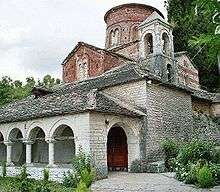Dormition of the Theotokos Church, Labovë e Kryqit
| Church of the Dormition of the Theotokos Kisha e Fjetjes së Virgjëreshës (in Albanian) Ναός Κοιμήσεως της Θεοτόκου (in Greek) | |
|---|---|
 | |
| Basic information | |
| Location | Labovë e Kryqit, Albania |
| Geographic coordinates | 40°04′26″N 20°17′25″E / 40.0739°N 20.2902°ECoordinates: 40°04′26″N 20°17′25″E / 40.0739°N 20.2902°E |
| Affiliation | Eastern Orthodox |
| Country | Albania |
| Architectural description | |
| Architectural type | Church |
| Architectural style | Middle Byzantine (circular dome with peristoon) |
The Church of the Dormition of the Theotokos (Albanian: Kisha e Fjetjes së Virgjëreshës,[1] Greek: Ναός Κοιμήσεως της Θεοτόκου), simply known as Koimissi or Saint Mary church is an Eastern Orthodox Christian church in the village of Labovë e Kryqit, in Gjirokastër County, southern Albania.[2][3] It is one of the most representative examples of Byzantine architecture in Albania.[3]
History
The foundation of the church dates back to 6th century at the reign of Byzantine Emperor Justinian (527–565 AD).[3] Justinian erected the church in memory of his mother.[3] The present building dates from the 10th century or – according to another source – 13th century, during the time of the Despotate of Epirus.[4]
The church retained a fragment of the True Cross due to a donation by the Byzantine Emperor. According to another tradition, the Byzantine Emperor donated the miracle-working icon of the Virgin, known as "Labovitissa" (Greek: Λαμποβίτισσα).[5] Until 1967, it was a pilgrimage destination for the surrounding Christian communities.[6] Each year on the day of the Dorminition of the Theotokos a procession of the Holy Cross fragment with the Labovitissa icon took place to the adjacent villages. In 1967, religious activities were forbidden by the atheistic policies of the People's Republic of Albania. Recently a number of initiatives to revive such festivities had limited results.[7]
The church has been declared a Cultural Monument of Albania.[8] Today, it's considered one of the most significant examples of Byzantine architecture in Albania.[9]
Architecture
The church shares a number of typical features of 9th–11th century Byzantine architecture. The connection of the central aisle to the subsidiary aisles as well as the narthex is ensured through a triple passage (tribilon).[10]
Several architectural elements found at the exterior of the building, such as the dome, the windows and the combination of brick- and stonework, are influenced from contemporary Byzantine churches in western Macedonia.[4][11] The 10th century dome is the oldest example of circular dome found in the region of Epirus, probably an evolution of the older octagonical style.[12] The fishbone pattern of the exterior is also found in a number of contemporary church buildings in Epirus, western Macedonia and Lakonia, in Greece, although not a quite common feature in Byzantine architecture in general.[13]
See also
References
- ↑ Flora Koka (2003). 2000 vjet art dhe kulturë kishtare në Shqipëri: aktet e simpoziumit ndërkombëtar, Tiranë, 16–18 nëntor 2000 (in Albanian). Kisha Orthodhokse Autoqefale e Shqipërisë. p. 139.
- ↑ Veikou, 2012, p. 126 & 127: "at Koimissi in Labovo"
- 1 2 3 4 Dawson, Linda White and Peter and Andrea (1995). Albania : a guide and illustrated journal (2. ed.). Chalfont St Peter: Bradt. p. 71. ISBN 9781898323105.
Labova e Vogel — 30km to the northeast for its 10th century Shen Meri church built by Justinian for his mother, the most important example of Byzantine architecture in Albania
- 1 2 Christopoulos], [publ.: George A. (2000). The splendour of Orthodoxy. Athens: Ekdotike Athenon. p. 502. ISBN 9789602133989.
Much attention is paid to the exterior of the church as well (dome, decorated windows, combination of brickwork and stonework). A typical example is the church of the Panagia at Ano Lambovo, of the tenth century (or the thirteenth, according to others).
- ↑ Eade, Katić, 2014, p. 104
- ↑ Eade, Katić, 2014, p. 105
- ↑ Eade, Katić, 2014, p. 117: " ...kept in labova's church, to a number of local villages – a tradition that is said to have persisted until 1967. However, the church's feast day and pilgrimage is nowadays but a shadow of its past."
- ↑ "Religious buildings with the "Culture Monument" status". Republic of Albania National Committee for Cult. Retrieved February 1, 2015.
- ↑ Hammond, Nicholas Geoffrey Lemprière (1967). Epirus: The Geography, the Ancient Remains, the History and Topography of Epirus and Adjacent Areas. Clarendon. p. 209.
At lower Labove the church of the Koimesis Tes Theotokou is a fine example of Byzantine architecture
- ↑ "The Holy Mother Assumption Church, Velushina". http://seecorridors.eu. Cultural Corridors of Southeast Europe. Retrieved 14 September 2015. External link in
|website=(help) - ↑ Sakellariou, M. V. (1997). Epirus, 4000 Years of Greek History and Civilization. Athēna: Ekdotike Athenon. p. 196. ISBN 9602133716.
...domed church with is peristyle and lavish decorative brickwork, was influenced as regards its plan, its careless masonry and its typological features by the architecture of western Macedonia
- ↑ Kaponis, Nikolaos (2005). "The Naodomic Architecture of the Despotate of Epirus, in the Era of the Dynasty of Comnenoi Angeloi (1204–1318)". www.didaktorika.gr (in Greek). University of Ioannina. pp. 314, 316. doi:10.12681/eadd/13781. Retrieved 15 September 2015.
- ↑ Veikou, 2012, p. 127: The fishbone pattern, although not very common during the middle Byzantine period, is also found in buildings throughout Epirus, Western Greek Macedonia and Lakonia.
Sources
- Eade, John; Katic, Mario (2014). Pilgrimage, politics and place-making in Eastern Europe : crossing the borders. ISBN 9781472415929.
- Veikou, Myrto (2012). Byzantine Epirus: A Topography of Transformation. Settlements of the Seventh-Twelfth Centuries in Southern Epirus and Aetoloacarnania, Greece. Leiden: BRILL. ISBN 9789004227460.